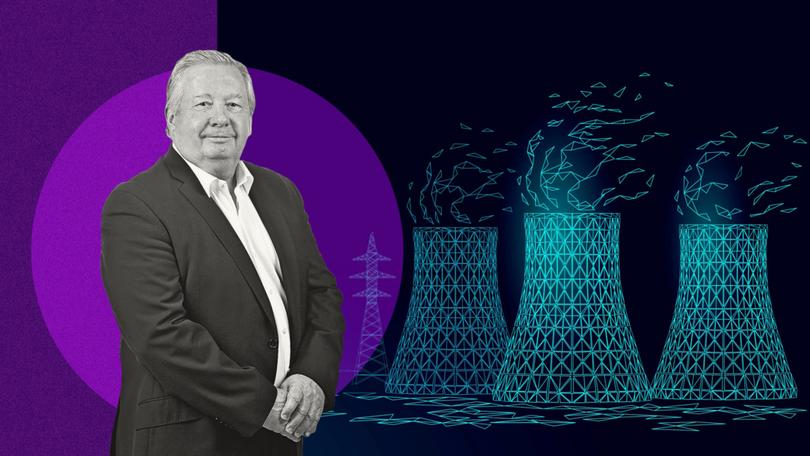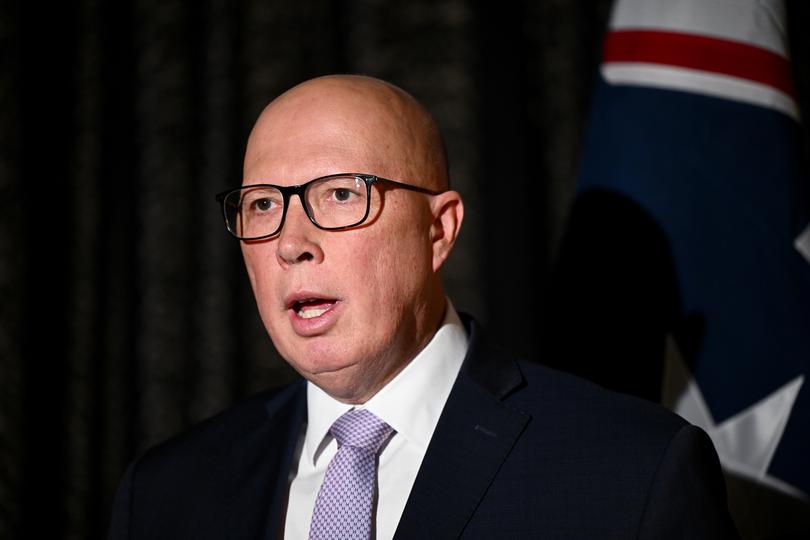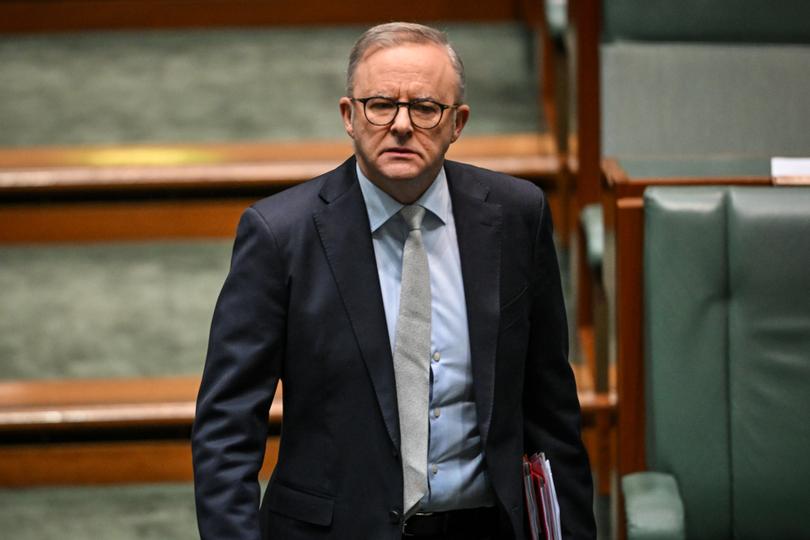PAUL MURRAY: Labor’s refusal to have a sensible discussion on nuclear power leaves us all in the dark

Under a plan personally approved by Anthony Albanese, up to 600MW of nuclear power will be operating near Rockingham within three years.
So why is he running a scare campaign over where the Coalition might put nuclear reactors many years into the future?
One thing certain from the AUKUS deal that the Prime Minister backs is that five Virginia-class submarines — each with a 210MW General Electric S9G reactor aboard — will rotate through HMAS Stirling on Garden Island from 2027.
Sign up to The Nightly's newsletters.
Get the first look at the digital newspaper, curated daily stories and breaking headlines delivered to your inbox.
By continuing you agree to our Terms and Privacy Policy.Consider this scenario: It is expected that as many as three of the four American and one British submarines could be at Stirling at one time.
This would effectively be putting a medium-sized nuclear reactor within 10km of Rockingham’s famous Swinging Pig hotel where former Stirling navy grunt and Labor hero Mark McGowan bought victory drinks for the locals in 2020.
It is directly opposite where McGowan’s government decided to build a $6 billion commercial port on the same Cockburn Sound channel the nuclear-powered submarines will use.
Many of the 60 nuclear reactors currently under construction in 16 countries — the ones Labor ignores when it argues nuclear power isn’t feasible — are around 600MW in size.
The eventual plan is for half the potential Australian nuclear submarine fleet of up to 12 to be home-ported at Stirling by the 2050s. That’s 1200MW of nuclear power on our doorstep — the same size as most of the 26 whoppers China is now building.
Not only is Labor clearly unconcerned about the siting of this naval nuclear facility, but it also wants Australians working within metres of a reactor while serving on the submarines. And those building them.
Albanese sees no inconsistency in running a NIMBY campaign about the Federal Opposition’s plans to site nuclear power stations on land previously used for coal-fired generators to make efficient use of their transmission infrastructure.
Why does a small nuclear reactor work cost-effectively in an Australian submarine, but not for land-based power generation?
One of the first and loudest of the Labor MPs opposing the Coalition’s nuclear plan was Education Minister Jason Clare. Within days of Opposition Leader Peter Dutton announcing he would take a nuclear power policy to the election, Clare was demanding to know where the reactors would go.
The same man days earlier announced a $150 million plan to “start delivering the skills and workforce we need to deliver Australia’s nuclear-powered submarine program through AUKUS”.
“The AUKUS plan for Australia to acquire and manufacture nuclear-powered submarines will create around 20,000 direct jobs over the next 30 years across industry, the Australian Defence Force and the Australian Public Service,” Clare’s statement said.
It seemed he couldn’t say the word “nuclear” enough in that statement: “Australia’s nuclear-powered submarine program will be the most transformative industrial endeavour in our history.”
So would any of those workers be near a nuclear reactor? How many of the 20,000 would be nuclear technicians and engineers?
We know Clare is worried about radiation because he tweeted about the Coalition’s nuclear plan: “I think Peter Dutton has spent too much time staring at the microwave.”

That’s someone with very little understanding of “the science” of nuclear energy. Our schoolchildren deserve better.
Clare’s electorate adjoins the one that has housed the Lucas Heights nuclear reactor, built by the federal government’s Australian Atomic Energy Commission, since 1958.
If he wants to visit, it’s just a 20-minute car ride down the A6 from his electorate office. He might learn something.
It is a discredit to our nation that our politicians can’t have a sensible debate about nuclear power that doesn’t veer into emotion and scare tactics.
That’s mainly because of an undergraduate view of the world that characterises modern Labor whose MPs generally left university and went straight into politics without real-world experience. It’s worse since they need to pander to the Greens for preferences.
To further confuse Labor’s nuclear position, Energy Minister Chris Bowen claims neighbouring countries are not going nuclear, specifically naming Indonesia, just as Trade Minister Don Farrell signed a new agreement under which we support the take-up of small modular reactors in participating countries, including Indonesia.
There is another massive inconsistency between Labor’s aversion to nuclear power and its embrace of the AUKUS submarines.
Albanese claims Australia could not build a nuclear power station within 20 years and consistently uses this straw man to rule it out. But he is prepared to wait more than 20 years to get the first Australian-built nuclear-powered submarine.
Where’s the logic in that?
A former chairman of the World Nuclear Association, Australian Tony Grey, this week tore apart the CSIRO’s latest downplaying of N-power in its latest GenCost energy comparisons, saying it “grossly exaggerates the costs of nuclear and the time needed to build the small nuclear reactors ideally suited to Australia”.
“Rather than the stab-in-the dark forecast by GenCost that SMRs here would take 20 years to bring into production, Tony Irwin, a nuclear engineer who has run a nuclear plant in the UK, estimates it to be about 10 years, the length of time required for offshore wind farms,” Grey wrote in The Australian.

He pointed out that a tiny country like Estonia, with a population of 1.4 million and a GDP of only 2 per cent of Australia’s, was pursuing a nuclear future, to diversify its energy mix by 2035 when it plans to discontinue its use of oil shale.
“In a report to the government, a nuclear working group concluded that adopting nuclear power in Estonia is feasible,” Grey wrote.
Bowen, also writing in The Australian two weeks ago, pointed to Germany’s rejection of nuclear power as the exemplar. But its decision to go heavily renewables has made its domestic power costs the highest in Europe, 41 per cent above the EU average.
Even Labor’s reaction to Dutton’s plan to disregard Australia’s 2030 Paris Agreement target, while he still steadfastly commits to the main game — net zero by 2050 — is irrational and illogical.
Everyone knows that Australia has no hope of meeting the earlier target. Even Bowen admits it entails installing 40 wind turbines every month and 22,000 commercial solar panels every day.
But under Bowen’s muddled line of thinking it’s noble to fall short of an unachievable target — but not to change it to an achievable one to smooth the path ahead.
Eight G20 countries — Argentina, South Korea, Saudi Arabia, Russia, Turkey, Canada, Mexico and Indonesia — are all pursuing policies rated as “critically insufficient” to meet their 2030 targets.
China, Brazil, Australia, the EU and the UK are all “highly insufficient”. Another five G20 countries — the US, Japan, South Africa, Germany and India — are rated “insufficient” in Climate Action Tracker’s “fair share” analysis.
At the United Nations’ COP28 summit in Dubai in December, Australia reported an increase in annual greenhouse gas emissions of four million tonnes.
As Coalition energy spokesman Ted Evans pointed out, if Labor were on track for 2030, it should have reported a reduction of 17 million tonnes.
The real danger to energy planning built around an unachievable renewables target is that it eventually leaves consumers short of reliable power. It’s that simple.
The reaction of global warming evangelists to Dutton’s revised 2030 target position has been a study in irrelevancy. They lined up to write letters to various editors that the coalition would not win back any of the Teal seats because former Liberal voters who decamped wanted “action” on climate change.
They profess to follow “the science” but disregard Australia’s chief scientist, who says cutting our emissions to zero today would have a negligible effect on climate change.
That’s not a reason to do nothing, but a cause for moderation. It’s what big emitters do — like China and India, both rapidly pursuing nuclear energy — that counts.
Don’t these free thinkers demanding “action” see Dutton isn’t saying no to more renewables, but wants to include nuclear to underpin them? And that most Australians support nuclear.
Here’s something they can ponder during the bun fight over Labor’s clearly unachievable target of 82 per cent renewable energy by 2030.
As Perth entered its evening peak energy consumption period on Wednesday, the Government-owned network that powers our homes was 94 per cent dependent on fossil fuels.
The website of our market operator, AEMO, showed that at 4.57pm on a cloudy and windless day, Collie coal was still meeting 42 per cent of the evening demand, with gas contributing 52 per cent.
WA Labor promised two years ago this month to shut Collie coal in 2029, just five years away. The Greens are trying to outlaw gas.
On Wednesday afternoon, the wind was providing only 3.3 per cent of our needs, with solar contributing virtually nothing — as it had all day.
Without coal on a similar day in 2030, Labor would have to find an extra 1164MW of power to meet the evening demand.
From where?
